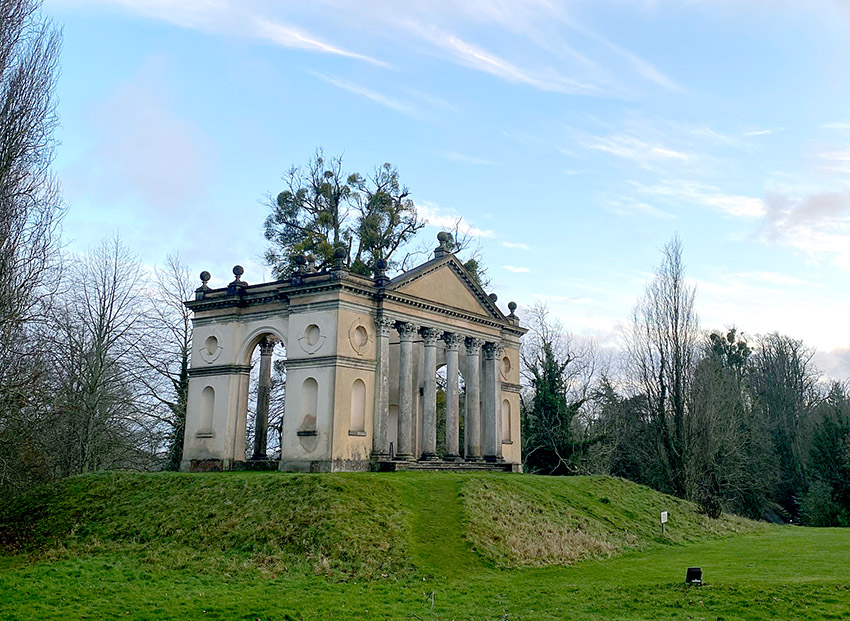
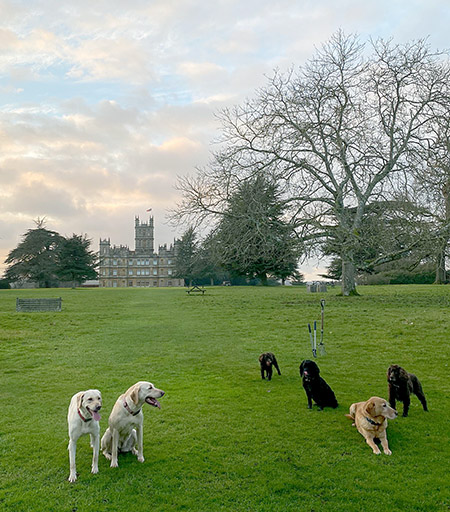 The dogs are happily snuffling around in the shrubs which surround the raised classical temple in which I am standing. Its floor stands about 12ft above the current level of the lawns and, when it was built, it would have been level with the long gallery or library which faced it in the 18th century building, Highclere Place House, which originally stood here on the site of the current Castle.
The dogs are happily snuffling around in the shrubs which surround the raised classical temple in which I am standing. Its floor stands about 12ft above the current level of the lawns and, when it was built, it would have been level with the long gallery or library which faced it in the 18th century building, Highclere Place House, which originally stood here on the site of the current Castle.
The temple, a harmonious and elegant eye-catcher, is called Jackdaws Castle, perhaps for the simple reason that there used to be an avenue behind it in which Jackdaws used to roost. It’s history, though, is somewhat grander. The pillars used to stand as part of the portico of one of the smartest houses in London: Berkley House. Built in the reign of Charles II – around the time of the Great Fire of London in 1666 – it was later bought and renamed Devonshire House by the family of the same name but sadly burnt down whilst being refurbished in 1733. The columns were presumably deemed no longer needed and sold off a few years later. Robert Herbert, Geordie’s predecessor, bought them and had them transported to Highclere by horse and cart.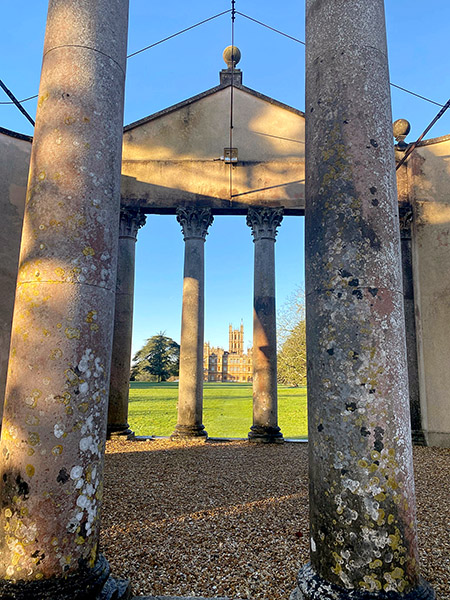
Once roofed, today it stands open to the elements but the proportion of the columns follows the harmonious classical principles so much admired by 18th century architects and intellects. The Corinthian, the most ornate of the classified orders of columns, is characterized by slender columns and elaborate capitals decorated with acanthus leaves and scrolls.
The “capital”, derived from the Latin caput or “head”, forms the topmost part of the column and mediates between the column and the load thrusting down upon it by broadening the area of the column’s supporting surface. This is not, in fact, needed here but might have been in the earlier building of which the columns were part.
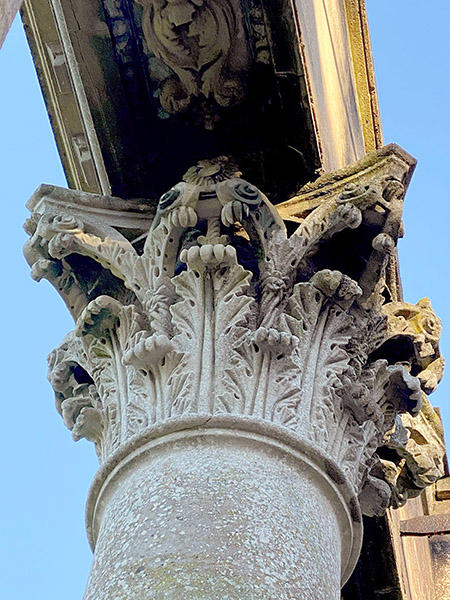
The Highclere capital
The “capitals” in Jackdaws Temple represent an allusion to heritage, culture and architectural fashions of early millennia and, somehow, the intrinsic sense of connection through time and place. The same word, of course, also describes both a major city and a person’s wealth, from the Medieval Latin “capitale” stock, property. This past year, every one of us both as individuals and as governments have had to ask some searching questions in terms of capital and revenue and their importance in relation to other needs.
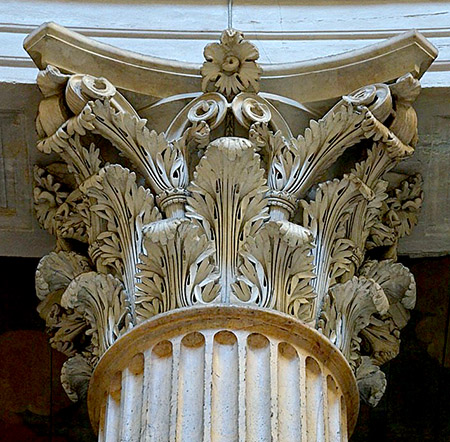
The Pantheon Capital, Rome
Our Temple is related to the landscape here and is not something from which we can derive a revenue. It adds to, and defines, its immediate landscape and is just ours to look after for the future.
Perhaps, above all, the quietness of this past year should have reminded us, among other things, of the capital value of nature and our selfishness in how we remove and dispose of it. We take oil and fuel, we take nutrients through overuse of land with single crops, ancient forests are cut down, metals removed from the earth and seas polluted.
Researching money investment schemes, sensible investors firstly seek to reassure themselves about the preservation of their capital before looking at the promise of income. Curiously few of us have applied the same thought processes to the world in which we are lucky enough to live. Rather like a Ponzi scheme we are stealing from the future to make today work, whereas really we should consider ourselves tenants and put our imaginations towards making the best use of the revenue.
“We don’t inherit the earth from our ancestors, we borrow it from our children.” Native American proverb, to put it another way: The earth has music for those who listen. —William Shakespeare. A very happy new year to you all.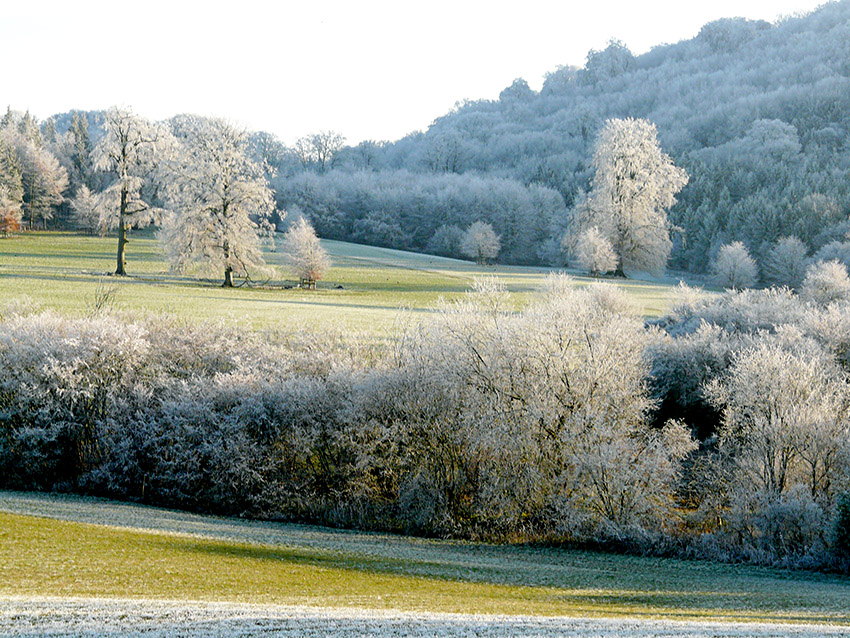








 Instagram
Instagram
I love your insightful reflections. Absolutely refreshing for the New Year of 2021. Wonderful. May your beautiful dogs frolic with you for the entire New Year on your magnificent grounds.
A happy New Year to you too. Enjoy so much reading your news letter and to know a little more about the English history.
Happy New Year!
Refreshing thoughts and so well expressed. We are the guardians of tomorrow and should never forget how the planet nurtures us.
Happy And Healthy New Year to you, your family, and all who work so hard to maintain and protect Highclere.
Dear Lady Carnarvon,
Thank you so much for your graceful and interesting Monday letters!
Reading today’s newsletter was just especially pleasurable for this student of art and architecture history. I have saved every single one of the photographs, they are just so beautiful and beautifully detailed. Your engaging style makes even the prosaic topic of money (“capital”) interesting!
A favorite verse: “Much is required from those to whom much is given.” It keeps me mindful of being a good steward of the property entrusted to my care.
Best wishes as you start your new year!
Dear Lady Carnarvon, wishing you and family a very healthy and safe New Year. This blog, is spot on, I just hope that we all heed it, and understand how important it is for the years to come. Desiree.
Thank you for sharing this information and photos. I am glad your husband’s ancestor had the foresight to save it.
I am too
I love these Follie
Dear Lady Carnarvon,
The fruits of your land helped me welcome in the New Year – Highclere Castle Gin.
Blessings to all for a “reboot.”
Holly
That is great to hear!
Love it
I love reading your blog, always uplifting and so informative. Looking forward to reading your insightful blog in 2021.
Wishing you and your family a very healthy, inspirational and happy 2021!!
And I love seeing your adorable pups! Sadly this year both of our sweet grand-dogs passed away. But both being 14 years they both lived a long and spoiled life. We loved every minute we all had with them. They’ll forever be in our hearts.
With all best wishes!
A most Happy and Healthy 2021 to you and all at Highclere. What a beautiful way to begin this Monday than you showing us the “capital” from ancient Greek city of Corinth. May we preserve and respect the structure Mother Earth as we have our ancient structures. Thank you for your words of wisdom.
Thank you for your words from Greece!
As always, thank you for sharing your beautiful piece of history!! Happy New Year to you and your family!
You don’t have to share, but you do!
Your unselfishness, deep concern and thought provoking words are much appreciated.
Thank you
Dear Lady Carnarvon,
Thank you for another beautifully written and informative blog. I look forward to Monday’s read and often wonder, Sunday, what your blog may be about. Thank you again for sharing Highclere with us.
Pam Oates
Happy New Year .
And to you – happy New Year
I love this particular blog. It’s very insightful and I agree wholeheartedly. It’s time everyone look at the larger picture, which has become much clearer this past year.
Wishing you and yours a very Happy New Year.
What wise and beautiful sentiments to begin the New Year Lady Carnarvon -and stunning photos as ever. Thank you and a Happy New Year to you and your family!
Happy New Year Lady Carnarvon and thank-you for the wonderful Blog. You help to bring civilization back to an uncivilized world. Blessings and Greetings from Nova Scotia Canada
What wise and beautiful sentiments to begin the New Year Lady Carnarvon -and stunning photos as ever. Thank you and a Happy New Year to you and your family!
Dear Lady Carnarvon,
a very Happy New Year to you and everyone! Fascinating piece of history, and interesting to see how building parts get reused. The frosty scene across the park is beautiful.
Good health everyone!
Jane
With all Best Wishes!
Thank You Lady Carnarvon for your weekly Blog. Gives me hope that everything that is near and dear are not crashing down around Us. Wishing You and your family a Most Healthy and Happy New Year.
Thank you – we go down and we go up
Guessing those columns were cut down into pieces to transport by horse and cart from London? Leads me to wonder how they were reassembled from within to make them strong and stable.
I especially love your last photo of frost covered trees and meadow and the long early morning shadows. Thank you also for regularly sharing photos of all your dogs! May you all have a new year of health and renewed HOPE.
Ina Sue
Bellingham, WA
There are no joins – they were transported in one piece
Happy New Year Lady Carnarvon!
On my very first visit to Highclere I was thrilled to hear your “Art & Architecture” chat – from the first row no less – and then I spent at least three hours just wandering around the grounds and taking it all in. A joyful, magical day I will long remember.
The best thing about Monday is reading your wonderful essays about Highclere, but I admit a special fondness for the architectural history. This one was particularly fascinating and thought-provoking. Thank you for this treat – I read slowly because I know I must wait seven days before reading any more.
Joan Lerch,
Webster Groves, Missouri
How kind you are Joan.
Happy New Year to all! I am a newcomer to your weekly blog Lady Carnarvon and look forward to the adventures to come. You have brought hope to this Ohioan.
Thank you
I truly enjoyed this week’s post. It reminded me of long ago high school Latin class where we were taught the differences in architecture styles of columns. Also, the Native American proverb – well said. Happy New Year, Lady Carnarvon, to you and yours!
This was a most beautiful read and reflection this morning.
Many of us have tried to take in all the lessons of this past year and look forward to a year of “renewal”. That is my word for 2021.
Thank you for writings, videos and posts. I enjoy them all immensely.
Blessed New Year to you and your family.
Renewal is a good word – we cannot go back to normal
Hello Lady Carnarvon,
Had a bad experience when I visited Jackdaws Castle some years ago as one visitor told me, not ask, to move as they wanted to take a photo.
Looking forward to your next program BBC 4 Tuesday 9pm. How you find the time and the energy amazes me. Must be the fresh air.
Lots of fresh air recently!
Love the blog: As we all know some blogs can be well meaning but are a bit dry or leave you with your eyes rather wider than normal. But not your blog and thank you. Looking forward to reading more as we battle the Virus and hold dear the importance of Democracy which I hear the Late PM Winston Churchill all the time in my mind “KBO” when I think no more here in America could go down the rabbit hole as if we were Alice in Wonderland. And may we all have a much better New Year.
New Years Greetings to you and Lord Carnarvon,
Thank you for your once again educational and informative Blog 1 of 2021. Again lovely photos and interesting reading. So glad you, your families and all of Highclere Castle staff made it through Covid 2020. As I promised, we did send out 2020 and welcomed in 2021 with a tasty toast of a refreshing Highclere Gin & Tonic! It was a great way to end a challenging year and wonderful way to welcome in a hopefully, much better year ahead for all.
Cheers!
Lynn Barber
Thank you!
Thank you for a very thoughtful piece. The last part is the most important — how we are misusing so many of our resources. I feel that it is imperative that we find, and use, better farming methods as well as energy sources that do not deplete our home planet.
I hope – indeed know – we are thinking about evert action we take here…
Hello Lady Carnarvon
Enjoyed very much reading your post today. Very uplifting. Are those English labs in the picture? They are beautiful
Mike CAlogridis
Labradors are really from Canada – but these are now English!!
Capital is an interesting concept. In thinking about it, I believe that our children are our “capital.” The investment of time, nurturing, and love will “pay off” in the future. Your weekly narratives open the mind to new possibilities of thought. To a capital New Year! “If you know what people need you have gotten more knowledge of a fortune than any amount of capital can give you.”
― Russell H. Conwell
A happy New Year to you!
Lady Carnarvon,
The architectural history you have covered this morning reminds me of a 5th grade history lesson where we were required to identify and know the background of the three types of columns – Corinthian, Doric and Ionic. I fell in love with Corinthian and the intricate beauty of a talented mind or minds who designed it. Thanks for a wonderful memory. I hope you continue your delightful history lessons as you enjoy your present and future on the beautiful grounds of Highclere. Thanks, too, for the beautiful pictures!
Martha
Thank you Martha
Another superb blog with art history and the background of a word, all related to Highclere, thank you! My favorite is still “hole weg” which I think about when coming across a low road. Happy New Year to all at Highclere!
Thank you – The winter can expose our past travels and outline these hollow ways!
I always enjoy reading your blog and seeing the photographs you post. Thank you so much.
Enjoyed your blog today – always my Monday treat! I looked up the definition of folly and found this one – “an often extravagant picturesque building erected to suit a fanciful taste”. My visit to Highclere was so wonderful but I didn’t save enough time to walk around. Next time I surely will! Love the “Capital” definitions – thank you for your history lessons! I can hear the doggies snuffling around – so happy they get to enjoy the grounds! Happy New Year!!!
Happy New Year – the gardens here extend every year and I hope offer time to sit …
Such a fantastic piece of architecture is this lovely temple . . . and what a setting. Simply breathtaking! I received your book, “At Home at Highclere” as a thoughtful Christmas gift from my daughter. She knows here Daddy well and his love of English country homes, architecture and lifestyles. (Eager to try out the Highclere Scotch Egg on page 186).
Perhaps some day, you will share with us some photographs and information on the rooms in the tower (even if they have yet to be restored). Always fascinated by this piece of the castle
Thank you for sharing so much of you lives and your home with the world. It fills my leisure time in retirement here in Franklin, Tennessee.
Best . . .
Thank you so much – the books I write are hard to classify and I worry about selling them as a result. “At Home” has so much in it form recipes and you are right yummy scotch eggs, to Charles Adams, royalty, afternoon tea and Henry Jame. Thank you to your daughter too
Beautiful and thoughtful, coming from a farming back ground our ethos was always we are here to look after the countryside for the future of others. I was never lucky enough to become a farmer so I became an estate gardener and the same rules still apply. I always look at the cedars and oaks and wonder in awe about the fore site of their planting especially as the people who planted them would be unlikely to see them at maturity. In a world of instant and throw away, I always feel proud to plant something that will be hopefully still be around in 100-200 or even 300 years time. If you look after the land, the land will look after you.
I so agree – it gives me a sense of calm in the hurly burly of today
Dear Lady Carnarvon:
Happy New Year .
Your Monday blog is a welcomed read to start 2021.
Thank you for sharing both family and general world history, along with the great pictures and words.
Until next Monday, all the best for a productive week.
Perpetua Crawford
Thank you
Loved Jackdaws Castle when we were there in 2019! My husband and I sat up there and took in all the beautiful flowers and trees that we could see. So anxious to come back again!
Dear Lady Carnarvon,
Happy New Year! I am so interested in your Labrador Retrievers! We have a black female from the Sandylands Kennel in Leaminton Spa! Looking at your labs, they have such a nice length of leg. Do you have your own breeding kennel at Highclere Castle? Or do you acquire them elsewhere? I really like the “older style” English Lab so we curious about your labs.
If you have any general information you would like to share, I would appreciate the information!
Thanks so much~
Sincerely,
Jenny Bloom
P.S. we visited Highclere Castle in 2018 and had a grand time!
Thank you – this is my fourth generation of labradors and each one is very carefully considered!!!
Dear Lady Carnarvon,
Happy New Year. I couldn’t agree with your philosophy more.
I’m now watching Downton Abbey for the third or fourth time – so many that I’ve lost track. What an amazing experience it must be to live in such a magnificent place with so much history. Thank you for your wonderful posts.
Happy New Year to the dogs—several of whom we have met before. Oh, and also to you and your human family 😉
Thank you!!!!
Well said, Lady Carnarvon! Thank you for an enlightening post. I love the Native American proverb because of the truth it speaks. What are we leaving our children and grandchildren? We are not living up to our responsibility to making this world better for generations to follow.
The Corinthian columns remind of the Parthenon on the acropolis in Athens. The Greeks left a legacy that resonates in the world today. Will we leave something worth remembering for good?
Peace, love & joy in 2021!
Ada
Lady Carnarvon, the Temple is beautiful, so much History. The photos are stunning. I wish for you much happiness and excellent health today and always. With Best Wishes, Cheryl
Dear Lady Carnarvon,
I love the history you shared with us about the Temple and I could imagine the poor horses dragging a groaning cart atop with those columns. Today we see beautiful columns which are hollow and for show only but yours would have been solid stone. The Temple may be a “folly” but it sits very well at Highclere and is still being admired.
I agree with you about the responsibilty we have to take care of the earth for future generations, we who appreciate the beauty around us and tend it lovingly. That Native American saying sits very appropriately for me and I agree with their philosophy totally.
I believe we should have all learned through Covid that income is not the be all to end all, necessary though it is, a much more simple life can be just as rewarding. Investments and income should be seen as a means to a comfortable life and give us some extra to share with those less fortunate or to contribute to plans to improve our environment.
Happy New to all at Highclere and stay well. I am keeping the UK in my prayers and I hope this pandemic is controlled very soon.
Joy Roebig
Australia
Happy New Year Joy – I hope so too
Dear Lady Carnarvon,
Happy New Year!
I trully appreciate your posts, podcasts and short IGTV posts. I enjoy to hear and read the stories behind this beautiful place. Thank you for sharing these amazing chapters of Highclere’s history. Your work is a generous way to keep alive this heritage.
May 2021 be better for all the world.
Best wishes,
Andrea
Ecuador
Hear hear!!
Thank you! Very interesting! Happy New Year!
Happy New Year to you
MY DEAR LADY CARNARVON, RÍO CLARO 34° CELSIUS.
DOES MILADY HAVE A DEGREE IN ART HISTORY OR WORLD HISTORY?
I LOVE TO READ THE LADY’S BLOG EVERY WEEK, I EVEN READ ALL THE COMMENTS. ACESSING THE BLOG SEVERAL TIMES A DAY, THIS HAPPENS ALMOST DAILY.
CONGRATULATIONS!! VERY WELL WRITTEN . MILADY , ALWAYS MAKE YOURS FOLLOWERS LEARN. THANK YOU VERY MUCH. BEST REGARDS FROM BRAZIL.CHEERS.
VILA ALEMÃ
RIO CLARO – SP
BRAZIL
Virginia
Happy New Year from Delaware. I really enjoy your blog and pictures. We here are all looking forward to January 20th.
Reading your thoughtful blog is always a delight, and educational. As a retired teacher, I recognize the innate educator in your writing. I especially enjoyed learning the different names of the parts of Jackdaws Castle. Happy New Year !
Oh…one last thought. Did you ever find a way to keep track of your phone ? I was tempted to send you a Touch screen phone purse…in leopard.
Lady Carnarvon,
Thank you for this wonderful history and beautiful images. Wishing you a blessed and joyful new year.
Lady Carnarvon, your Instagram of the Castle, Stella and Freya is very much a feel good photo. It does me good to look at it. I am going to print it off and put it on the frig. With Kind Regards, Cheryl
Thank you!
Lady Carnarvon,
I love to read your blogs.
And your images are breathtaking.
I look forward to another year.
Happy New Year!
Blessings to you and yours.
Phyllis Simpson, USA
How very kind thank you
~~~~~~~~~~~~~~~~~~~~~~~~~~
Healthy and Happy New Year!
~~~~~~~~~~~~~~~~~~~~~~~~~~
Violet
I love all the columns. My favorite is Highclere Column. If I ever go back, I would love to spend more time and not be so rushed.
Thank you for sharing and Happy New Year!
Lovely photos and an inspiring message. Happy New Year to you as well.
Happy New Year
Thank you so much for your thought provoking Happy New Year Wishes. Being in touch this way keeps us close to one of our most favorite memories, visiting Highclere in 2017. Thank you for all you do for so many. We look forward to returning and your blog keeps us close in heart. May 2021 bring you every great joy and blessing.
Thank you for your blog. It enriches my English. And thanks so much for intertwining it with poetry and literature – it is such a rarity these days and is so exquisite. Your posts never get old.